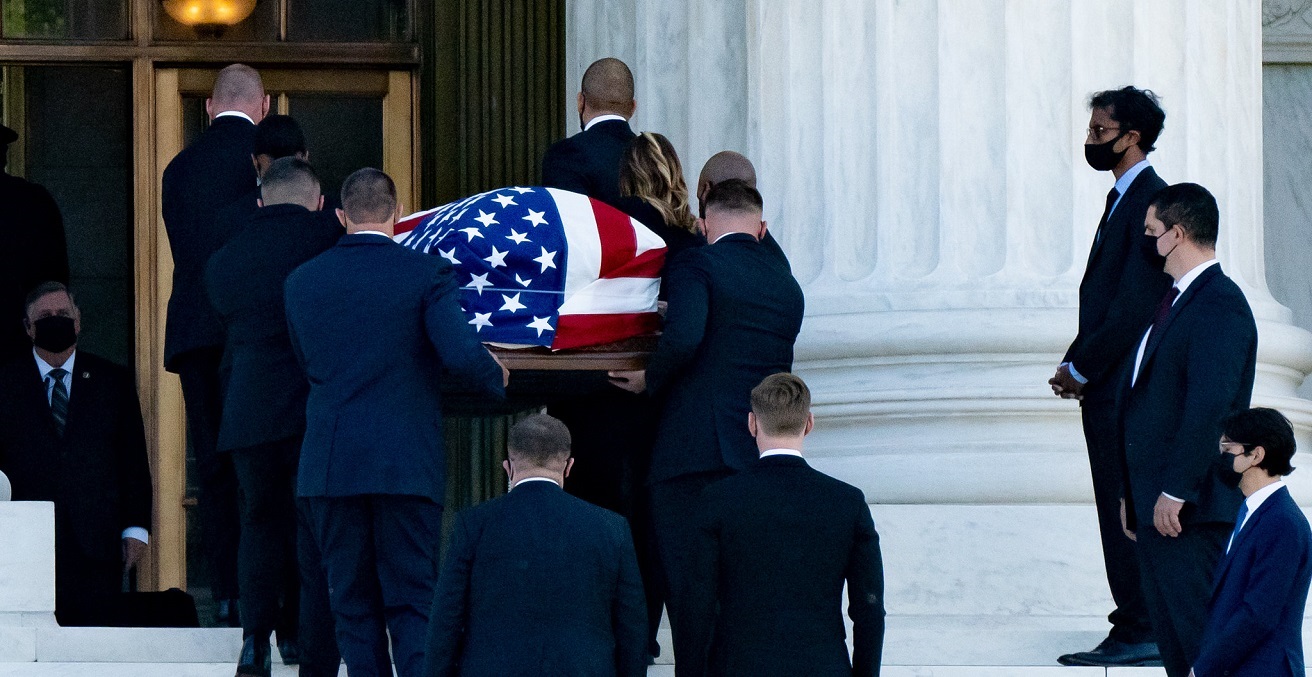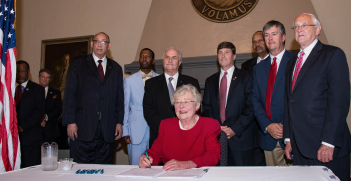Playing Politics with the Court: The US Supreme Court, Abortion, and Republican Electoral Strategy

For decades, opposition to abortion and Roe v. Wade has been central to Republican social, political, and legal identity. Following the death of Justice Ruth Bader Ginsburg, the future of the Supreme Court will be front and centre in the final weeks of the 2020 presidential election.
For decades, the Supreme Court has been a key staging ground in the American culture wars, attracting increasingly sharp partisan controversy that has focused heavily on abortion rights. Justice Ruth Bader Ginsburg’s death from metastatic pancreatic cancer on 18 September, just 46 days before the 2020 presidential election, ensures that the fate of the Supreme Court and legal abortion will be central in the last weeks of the campaign.
From Ruth Bader Ginsburg to Amy Coney Barrett
Ginsburg was the de-facto leader of the liberal justices on the Supreme Court and was viewed by many progressives as a hero for her long career advocating for gender equality, first as a lawyer and then as the second woman appointed to the Supreme Court. She was also a key judicial vote to uphold Roe v. Wade, the 1973 ruling that guarantees a woman’s right to an abortion.
Although Ginsburg’s most “fervent” dying wish was to “not be replaced until a new president is installed,” on 26 September 2020 President Donald Trump moved to fill her newly vacant seat. His pick is conservative jurist Amy Coney Barrett, who has been a judge on the US Court of Appeals for the Seventh Circuit since 2017.
Barrett, a 48-year-old devout Catholic, is a polarising choice for the vacancy, and is guaranteed to energise key segments of the Republican base. She was shortlisted in 2018 for the seat ultimately filled by Brett Kavanaugh, but passed over partly because of White House concerns that she was too controversial and that key Republicans might baulk at voting to confirm Barrett because of her opposition to abortion. Like her mentor, the late Justice Antonin Scalia, Barrett champions constitutional originalism, a legal concept which views Roe v. Wade and the broader right to privacy as a “fanciful reading” of the US Constitution.
From a Constitutional to a Judicial Strategy
Since the late 1970s, Republicans have made opposition to Roe v. Wade a central element of their social, political, and legal identity. But opponents of abortion did not always focus on the nation’s highest court. When the first vacancy occurred after Roe v. Wade, anti-abortion groups did not engage in sustained lobbying, and no Senator enquired about the nominee’s views on abortion. Instead, their core goal was to add a Human Life Amendment to the Constitution.
The dream of a constitutional amendment imploded in 1983 when a compromise measure failed to achieve even a simple majority in the Senate, falling 17 votes shy of the two-thirds majority required. After this, Supreme Court vacancies became crucial for opponents of abortion, which in turn has shaped Republican electoral strategy.
Roe — Politically Controversial but Popular
Although Roe v. Wade is the subject of intense partisan competition in the US, its popularity with the public has remained stable since the late 1980s. Most Americans support the ruling. Surveys last year found between 60 and 77 percent want to see the decision upheld.
More strikingly, abortion does not generally influence how Americans vote. From the early 1990s until the mid-2010s, only 13–17 percent of Americans described themselves as single-issue voters on abortion rights (a figure that includes both supporters and opponents). In the last five years, that number has climbed and currently sits at 24 percent, although the same poll found 25 percent of respondents did not consider abortion a major issue.
Anti-Abortion Voters
But simultaneously, opponents of abortion have always been more concerned that political candidates share their views on abortion. And for several decades, they have used their lobbying and political infrastructure to turn out the vote in state and national Republican contests and shape the kinds of candidates that appear on the ballot.
In 2000, interventions early in the primaries from anti-abortionists and the Christian Right were instrumental in George W. Bush’s emergence as the Republican nominee. In a country with non-compulsory voting, this small but highly motivated voting bloc is able to wield a disproportionate amount of influence.
Trump and the Supreme Court
Trump has made abortion and Roe a central element in both his presidential campaigns, which helped him attract and then maintain support from a significant proportion of white evangelical Christians, surprising many commentators. Anti-abortion and conservative Christian voters overlook both the secular and the moral controversies that surround Trump because since he has been in the White House, he has offered them both rhetorical support and substantive action.
In the 2016 presidential debates, Trump vowed “I will appoint judges that will be pro-life,” and viewed it as almost automatic that Roe would then be overturned. To assuage concerns that he was a political opportunist who was only paying lip-service to the anti-abortion and conservative cause, Trump took the unprecedented step of releasing two lists of potential Supreme Court nominees in the last months of the election campaign. Almost every proposed name had a track-record of firm opposition to abortion rights.
In 2020, just eight days before Ruth Bader Ginsburg died, Trump released an updated short list of potential nominees. The National Right to Life Committee and Susan B. Anthony List, the two most powerful anti-abortion lobbyist groups in the US, praised the list of nominees as “filled with all-stars.” These groups commit serious money and resources to election cycles; Susan B. Anthony List has launched a $52 million campaign to re-elect Trump. When Trump announced in the White House Rose Garden that he was nominating Amy Coney Barrett to the Supreme Court, anti-abortion leaders were amongst the 150 invited guests in attendance.
The New Conservative Majority
Even before Barrett was announced, Senate Republicans indicated they had the numbers to fill Ginsburg’s seat. If Barrett is confirmed, this will be Trump’s third Supreme Court appointment. Conservatives on the court will have a 6-3 majority, a shift in the balance of power that will almost certainly herald major consequences for Roe v. Wade and American jurisprudence more generally.
While the issue of abortion rights is currently attracting most of the political, legal, and media coverage, another conservative justice on the Supreme Court will have implications for a range of significant issues including the future of the Affordable Care Act, known as Obamacare, LGBT rights, gun rights, environmental rights, and potentially more established areas, such as voting rights. And if the election result is contested, the Supreme Court could play a key role in determining the victor, as it did in Bush v. Gore (2000).
Although the principle of separation of powers makes the judicial branch an independent, autonomous site of governance and constitutional review, the intense polarisation and partisanship surrounding Supreme Court vacancies and nominations has increasingly raised questions about its neutrality and legitimacy. This is a profoundly troubling development, for the Supreme Court ultimately determines the power and reach of the legislative and executive branches, along with the rights and liberties enjoyed by Americans.
Dr Prudence Flowers is a Senior Lecturer in US History in the College of Humanities, Arts and Social Sciences at Flinders University. She is a researcher and regular commentator on abortion politics in the United States. She is the author of The Right-to-Life Movement, the Reagan Administration, and the Politics of Abortion (Palgrave Macmillan, 2019).
This article is published under a Creative Commons License and may be republished with attribution.



